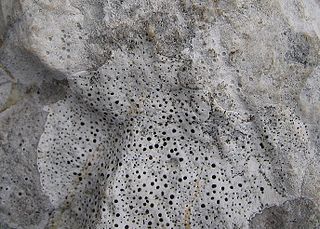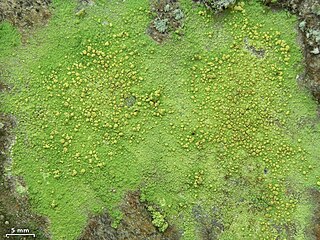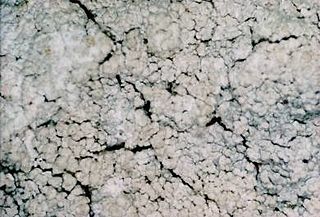
Verrucariales is an order of ascomycetous fungi within the subclass Chaetothyriomycetidae of the class Eurotiomycetes. Although most of the Verrucariales are lichenised, the family Sarcopyreniaceae consists of 11 species of lichenicolous (lichen-dwelling) fungi.

Verrucariaceae is a family of lichens and a few non-lichenised fungi in the order Verrucariales. The lichens have a wide variety of thallus forms, from crustose (crust-like) to foliose (bushy) and squamulose (scaly). Most of them grow on land, some in freshwater and a few in the sea. Many are free-living but there are some species that are parasites on other lichens, while one marine species always lives together with a leafy green alga.

Psilolechia is a genus of four species of crustose lichens. It is the only member of Psilolechiaceae, a family that was created in 2014 to contain this genus.
Sagenidiopsis is a genus of lichens in the family Arthoniaceae. It was circumscribed in 1987 by lichenologists Roderick Rogers and Josef Hafellner to contain the type species S. merrotsii, found in Australia. The characteristic features of the genus include the byssoid (cottony) thallus and bitunicate asci that lack amyloid structures that are apparent in the thallus.

Placidium is a genus of crustose to squamulose to almost foliose lichens. The genus is in the family Verrucariaceae. Most members grow on soil, but some grow on rock (saxicolous). The fruiting bodies are perithecia, flask-like structures immersed in the lichen body (thallus) with only the top opening visible, dotting the thallus. Lichen spot tests are all negative. Members of the genus lack rhizines, but otherwise resemble members of the genus Clavascidium.

Lepraria is a genus of leprose crustose lichens that grows on its substrate like patches of granular, caked up, mealy dust grains. Members of the genus are commonly called dust lichens. The main vegetative body (thallus) is made of patches of soredia. There are no known mechanisms for sexual reproduction, yet members of the genus continue to speciate. Some species can form marginal lobes and appear squamulose. Because of the morphological simplicity of the thallus and the absence of sexual structures, the composition of lichen products are important characters to distinguish between similar species in Lepraria.
Sagenidiopsis isidiata is a species of corticolous (bark-dwelling) byssoid lichen in the family Arthoniaceae. Found in tropical montane rainforests throughout Central America, South America, and the Antilles, it was described as new to science in 2011. The lichen is characterised by its cream-coloured to greyish thallus and numerous pseudoisidia, which are small, cylindrical outgrowths on its surface.

Lichens are symbiotic organisms made up of multiple species: a fungus, one or more photobionts and sometimes a yeast. They are regularly grouped by their external appearance – a characteristic known as their growth form. This form, which is based on the appearance of vegetative part of the lichen, varies depending on the species and the environmental conditions it faces. Those who study lichens (lichenologists) have described a dozen of these forms: areolate, byssoid, calicioid, cladoniform, crustose, filamentous, foliose, fruticose, gelatinous, leprose, placoidioid and squamulose. Traditionally, crustose (flat), foliose (leafy) and fruticose (shrubby) are considered to be the three main forms. In addition to these more formalised, traditional growth types, there are a handful of informal types named for their resemblance to the lichens of specific genera. These include alectorioid, catapyrenioid, cetrarioid, hypogymnioid, parmelioid and usneoid.

Roccellinastrum is a genus of lichen-forming fungi in the family Pilocarpaceae. It has seven species.

Lepraria incana is a species of dust lichen in the family Stereocaulaceae. First described scientifically by Johann Jacob Dillenius in 1741, and then formally by Carl Linnaeus in 1753, it is the type species of the genus Lepraria. The thallus of this species is green to greyish-green, and powdery – as if made of tiny granules. These granules are soredia, which are asexual reproductive structures. Like most members of genus Lepraria, the lichen has few distinguishing features, lacking both a medulla and sexual reproductive structures (apothecia). Chemically, the lichen is characterised by the presence of the secondary chemicals known as divaricatic acid and zeorin.
Lepraria santosii is a species of crustose lichen in the family Stereocaulaceae. It occurs in Tenerife, in the Canary Islands.
Huneckia is a genus of crustose lichens in the subfamily Caloplacoideae of the family Teloschistaceae. It has four species.
Lepraria granulata is a species of crustose and leprose lichen in the family Stereocaulaceae. It is found in mountainous locations of Eastern and Central Europe, where it usually grows over moss.
Phylloblastia is a genus of foliicolous (leaf-dwelling) lichens in the family Verrucariaceae. The genus was circumscribed in 1921 by Finnish lichenologist Edvard August Vainio, with Phylloblastia dolichospora assigned as the type species.
Botryolepraria neotropica is a species of saxicolous (rock-dwelling), byssoid (cottony) lichen in the order Verrucariales. It was formally described as a new species in 2010 by Martin Kukwa and Sergio Pérez-Ortega. The type specimen was collected growing with liverworts on shaded vertical walls in El Yunque. It also occurs in Bolivia and Peru, where it grows in shaded and damp locations. The species epithet refers to its Neotropical distribution. It is the second member of Botryolepraria, a genus circumscribed in 1997.
Gemmaspora is a single-species fungal genus of uncertain familial placement in the order Verrucariales. It contains Gemmaspora lecanorae, a lichenicolous (lichen-dwelling) fungus that parasitises the lichen genus Aspicilia. The genus was proposed in 2007 by David Hawksworth and Gökhan Halici to contain the fungus formerly known as Adelococcus lecanorae. This species, originally described by Roger-Guy Werner in 1963, occurs in Syria and Turkey.
Phylloblastia inexpectata is a species of foliicolous (leaf-dwelling) lichen in the family Verrucariaceae. Found in Europe, it was formally described by lichenologists Emmanuël Sérusiaux, Brian John Coppins, and Robert Lücking. The type specimen was collected by the second author in Dunskey Glen Woods, where it was found growing on the leaves of a Prunus laurocerasus tree growing near a stream. It has also been collected in England, southern Italy, Madeira, and Spain.
Kalbiana is a genus of saxicolous (rock-dwelling), crustose lichen of uncertain familial placement in the order Verrucariales. Both the genus and its only species, Kalbiana brasiliensis, were described in 1988 by lichenologist Aino Henssen. The genus name honours German lichenologist Klaus Kalb, while the species epithet refers to Brazil, where the lichen is found.
Austrographa is a genus of lichen-forming fungi in the family Roccellaceae. It has three species. The genus was circumscribed in 2013 by lichenologists Laurens Sparrius, John Elix, and Alan Archer, with Austrographa kurriminensis assigned as the type species. The genus had been published invalidly on two separate occasions. All three species in the genus were found in a mangrove stand in Queensland, Australia. The genus was discovered in Australia, and the name Austrographa reflects this.
Gossypiothallon is a fungal genus of uncertain familial placement in the order Arthoniales. It contains the single species Gossypiothallon appendisporum, a corticolous (bark-dwelling), crustose lichen found in South Solomons. Both the genus and species were described as new to science in 2014 by Dutch lichenologist André Aptroot. The type specimen was collected from Kolombangara island at an altitude of 700 m (2,300 ft), where it was found growing on bark.








